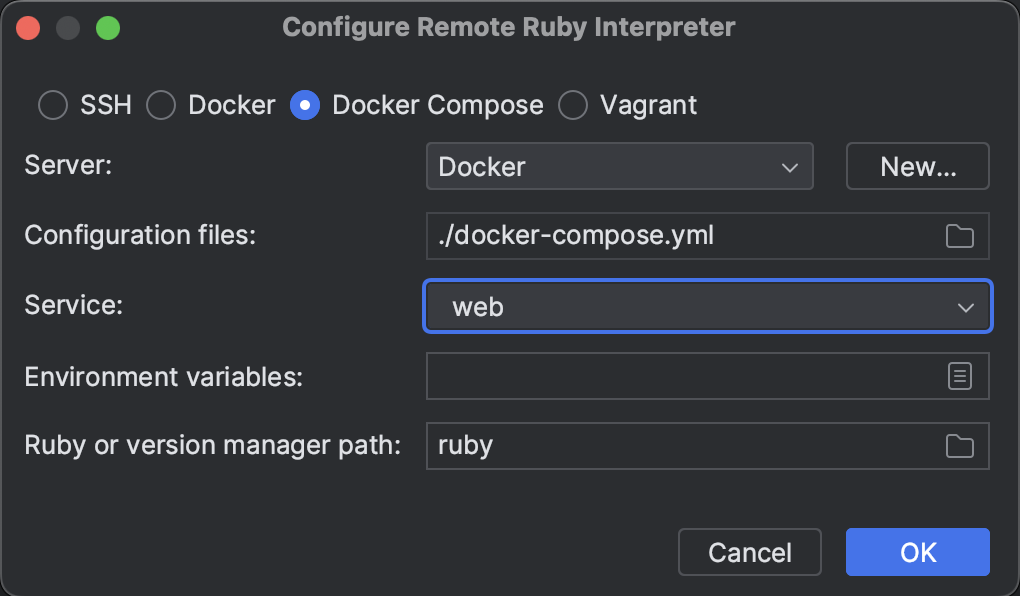This example app started by following the book Docker For Rails Developers and has been updated by me as time goes on. This is a "containerized" Rails app with the following primary features:
- Redis
- Postgres database
- esbuild for compiling JavaScript
- Transpiling Sass to CSS
- Testing with RSpec
- Debugging with breakpoints
- TODO: Deployment on Render
- TODO: Development vs production configuration
I've also included notes for using RubyMine and getting breakpoint debugging working nicely.
By default, Ruby buffers output to stdout, which doesn't play well with Compose. Let’s fix this by switching off Ruby’s output buffering. Add the following line to the top of your config/boot.rb file:
$stdout.sync = true
You will need to populate an .env directory at the root of your app. These files are sensitive and should not be checked into version control. The directory structure should look like:
.env
└── development
├── database
└── web
Those files are referenced in docker-compose.yml. Here is some example content:
.env/development/database
POSTGRES_USER=postgres
POSTGRES_PASSWORD=aGoodStrongPassword
POSTGRES_DB=myapp_development
.env/development/web
DATABASE_HOST=database
You'll need to define a remote interpreter for your project to get everything to play together nicely. Remember, you're not running Ruby off your local machine, nor are you installing any gems there. RubyMine needs to know where to look for all that stuff.
- Use the shortcut cmd+, to bring up Settings.
- Click + under Languages & Frameworks | Ruby SDK and Gems and choose Remote Interpreter or Version Manager.
- Choose Docker Compose
- Point Configuration files: at your
docker-compose.yml. - Select web as your Service:
- Click OK
Use Docker Compose to specify your needs in a declarative way and let it do all the heavy lifting.
docker compose up
# If anything seems "cached" and you wan to start fresh:
docker compose up --buildCompose will only build images if they don't exist. You are responsible for rebuilding things as needed.
If you've dockerized your Rails app, then you're no longer going to run rails commands from your local terminal. Heck, you might not even have the correct Ruby version installed or any of your app's gems. All that stuff is in the containers you've set up.
Instead, we can run bash and attach to the already running web container. (This assume you've already done docker compose up)
docker compose exec web bashNow that you've got an interactive shell, you can go to town with stuff like rails db:migrate or any other useful rails commands.
If you need to issue a command to a non-running container:
docker compose run web bashThis repo uses RSpec for testing and you can use rspec from an interactive prompt (like above) to start running tests, even JavaScript system tests with Capybara.
# Start all your containers
docker compose up
# Open another terminal window and
docker compose exec web bash
# Run your test like you normally would
rspecRubyMine has some built-in abilities to run our tests. Here's how I go about setting that up.
- Click Run | Edit Configurations from the main toolbar (MacOS).
- Click + and choose the RSpec configuration.
- Set Mode: to All specs in folder.
- Point Specs folder: to your tests folder. Usually /spec in your application's directory
- File name mask:
**/*_spec.rb - In the docker-compose section choose docker-compose exec. This is going to assume you're actively working on your code and have run
docker compose upto start all your services. - Click Apply and close out the window.
You should now have access to an RSpec option in the Run/Debug section.
You can see your system tests running in an browser by opening up the Screen Sharing app on your Mac. You'll connect to localhost:5900 and enter in the password secret. Doing this will allow you to watch the tests as they run -- they'll be fast!
If you would like to debug by dropping a debugger in your code to get an interactive session, you'll need to stop the currently running Rails server
docker compose stop webThen, you'll start it back up again, but in a slightly different way:
docker compose run --service-ports webOnce you've done that, your debugger breakpoints should work.
If you're interested in getting RubyMine's native debugging tools to work, like clicking to get a breakpoint in the gutter, you'll need to do the following:
-
Start all your services with either
docker compose upor by creating a Docker Run/Debug configuration.
-
Next, you're going to create a Rails Run/Debug configuration with the default settings and make sure docker-compose up is selected in the docker-compose section.

-
Now comes the key part. If you properly set up your remote interpreter mentioned in the housekeeping section you should be able to run the Rails configuration you just created. This will shut down the running web service and fire up a replacement. This is what allows RubyMine's debugger to attach and you can drop breakpoints in the gutters of your files and are able to use the GUI to step through things or use the console to inspect.
If you enjoy helpful things like what you've read here, consider stopping by my website matthaliski.com. You might find more useful info! 😁

